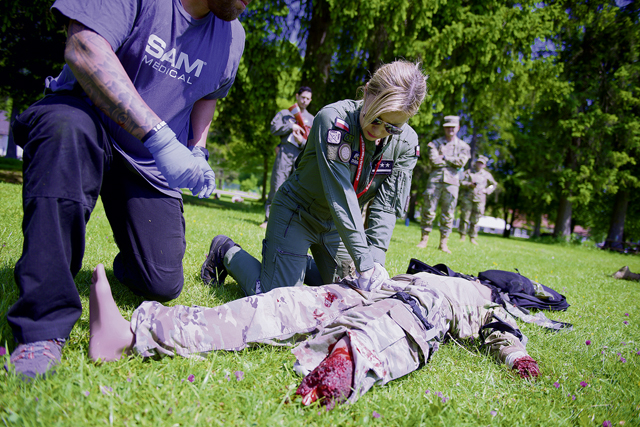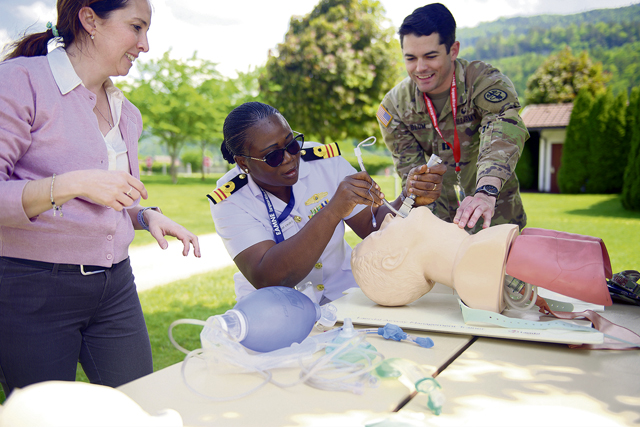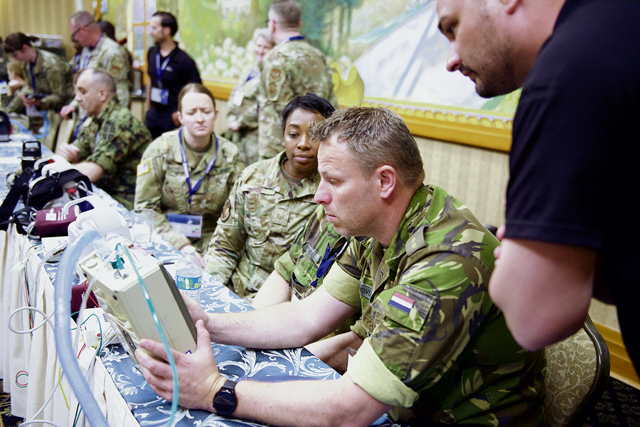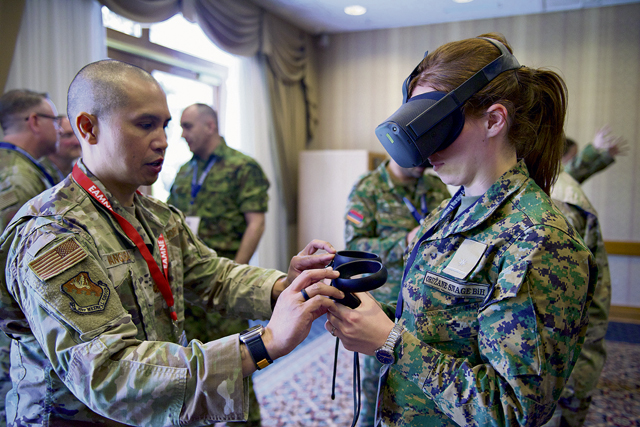
Nurses and medical professionals from 24 allied and partner nations, including the U.S., converged at the U.S. Air Forces in Europe – Air Forces Africa 2023 European-African Military Nursing Exchange conference, May 31 – June 2, to share medical knowledge and professional best practices with one another.
This year’s conference included military service members; National Guard and Reserve component medical professionals; and military delegations from South Africa, Madagascar, Zambia, Comoros, Angola, Algeria, Niger, Nigeria, Morocco, Ghana, Democratic Republic of the Congo, Cameroon, Uganda, North Macedonia, Serbia, Germany, Croatia, Albania, Poland, Kosovo, Azerbaijan, Bosnia and Herzegovina, the Netherlands, and Armenia.
The conference featured talks from various international medical professionals, centered on this year’s theme, ‘Military Medics: Optimizing Partnerships and Readiness.’
“This conference was very useful and interesting,” said 2nd Lt. Jasmina Balata-Pajt, nurse and medic for the Bosnia and Herzegovina military. “Especially the hands-on simulation, where I saw some new equipment that I could use in my country when I go back – thank you for this opportunity!”

The USAFE-AFAFRICA-hosted European and African Military Nursing Exchange, or EAMNE, began in 2014. This year’s event marks the eighth iteration of the conference, bringing U.S. allies and partners from around the world to a single location to collaborate and train together, improving medical readiness.
Several distinguished speakers presented at the conference, including Brig. Gen. Jeannine M. Ryder, commander of the 59th Medical Wing, San Antonio Military Health System, and Chief Nurse of the U.S. Air Force; and Brig. Gen. Clinton K. Murray, command surgeon for U.S. Army Europe and Africa and director of the Defense Health Region Agency Europe.
“It is an honor to be here with you today to speak on the Air Force Nurse Corps, but most importantly to build partnerships, create relationships and understand each other’s challenges,” Ryder said during her opening remarks at the event. “This conference enables networking and an ability to have open communication between many nations, bringing a diverse perspective on every problem.

“This diverse group can solve many concerns we tackle every day. Finally, it allows us to understand that we have the same purpose as nursing services in our respective militaries; we deliver a ready force and develop ready medics while providing safe, quality care to our patients.”
Ryder briefed alongside Chief Master Sgt. Chi Swandon, Aerospace Medical Service and Surgical Services career field manager. They both spoke on the state of the U.S. Air Force’s nurse corps and its outlook as it becomes more adaptive and agile.
Murray’s presentation focused on the trends and changes in medical readiness here in Europe and Africa, using a historical lens to explain the kind of opportunities and challenges today’s medics face.
“I think we have a generation of nurses that are amazing,” Murray said in his presentation. “The past couple of decades of large-scale combat situations in Iraq and Afghanistan have honed the skills and expertise of our medical professionals, more so in ways than the generation before them, making today’s U.S. military nurses some of the best in the world.”

He further described how U.S. medical professionals are increasingly working closer and closer with their allied and partner counterparts. He entreated attendees to progress in their mindsets from integrated, to interoperable, and finally to interchangeable: Interchangeability with our NATO allies and partners, in terms of medical readiness and capabilities, is the ideal state, he concluded.
Apart from the presentations, the conference predominately included various simulation sessions, in which practitioners had opportunities to hone their skills and get hands-on experience on new techniques and technologies. In years past, the conference was held at Ramstein Air Base, to take full advantage of the equipment necessary to demonstrate medical response efforts. This year, with space uncertain at Ramstein, USAFE-AFAFRICA was able to innovatively organize and ensure all the needed equipment could be collated at another location, supported by U.S. Army Garrison Bavaria.
For example, during the simulation sessions on the garrison, allies and partners were able to take full advantage of the U.S. Air Force’s relatively new Tactical Combat Casualty Care training program. They specifically practiced on the advanced tiers of the program, focused on combat medics and combat paramedics.
“We work closely, hand-in-hand, with our allies and partners,” said Staff Sgt. Kristen Gipson, noncommissioned officer in charge of education and training at the 52nd Fighter Wing, and wing TCCC advisor at Spangdahlem Air Base. “Having that common understanding of how we each react to medical situations and emergencies can help us evaluate our own U.S. Air Force processes, allowing us to incorporate best practices into our own programs and generally making us better as medics.”
Participants during the simulations got to practice on realistic manikins, practicing various medical techniques to manage massive bleeding, airway, circulation and hypothermia injuries. TCCC aims to help close the gap of preventable deaths to the goal of zero by teaching the five life-saving skills, as well as applying those learned skills with hands-on training.
“International cooperation is very important,” said 1st Lt. Marzena Dudaryk, a medic in the Polish Air Force. “Together we are stronger so it’s important to train together and to fight together.
“TCCC, for example, has a lot of different aspects and it’s helping NATO allies and their partners with their own medical programs. This opportunity here to learn about TCCC is a way to exchange our experiences and knowledge, to learn something new and be better as medics.”
The conference touched on a wide variety of medical subjects, from evidence-based practice on collaborative nursing strategies to overcoming patient movement continuum of care challenges. U.S. attendees were given Continuing Education Units, as the conference was considered a nursing continuing professional development activity, approved by the U.S. Air Force Nurse Corps and accredited by the American Nurses Credentialing Center’s Commission on Accreditation.
Moreover, for everyone who attended, the event served as a forum for international military medics to share best practices and strengthen interoperability with their allied and partner counterparts. There was no shortage of discussions and networking among nurses and medics.
“This is my first time attending the EAMNE conference and I’m really glad to attend,” said Lt. Cmdr. Amina Mildred Ogili, a military nurse for the Nigerian navy. “It’s an opportunity to learn, interact and meet new people from different parts of the world with brilliant and great ideas.”
Additionally, a huge benefit of the conference is the attendance of medical professionals from the U.S. Air Force’s sister services, medics from the U.S. Navy to the U.S Army, making the EAMNE a truly joint activity that hones medical readiness across the Department of Defense.
“What an amazing opportunity to learn from other nurses within the NATO alliance and from partner nations around the world,” said Minnesota National Guard nurse and medic, Capt. Stacy Buschmann-Ford. “By collaborating and learning from each other we become a united team, and by working together we all gain valuable knowledge.”
Enhancing medical readiness is dependent on networking and creating team cohesiveness with other exceptional nurses from around the world, she added. Buschmann-Ford recommends any U.S. military nurse and medic participate in a USAFE-AFAFRICA EAMNE event.
“Building partnerships and enhancing readiness is a priority for all of us, as U.S. Air Force medics and nurses,” said Col. Scott Tonko, USAFE-AFAFRICA medical operations division chief and command nurse. “We already look forward to planning next year’s event and trying to bring in more allies and partners from around the world.”


